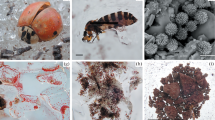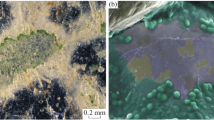Abstract
Ecosystems, in which the role of primary producers is played not by the photosynthetically active plants, but by the autochemolithotrophic microorganisms utilizing the chemical energy instead of the solar energy, have been described in the caves of eastern Turkmenistan. The zones of contact and interaction between the microorganisms and the mineral substrate perform the regulative, structuring, and bioaccumulative functions of surface soils. These zones have a vertically anisotropic profile forming in situ. Their functional and structural specificity makes it possible to consider them as bio-abiotic natural soil-like bodies and to apply the methods of pedology for their study.
Similar content being viewed by others
References
E. V. Arinushkina, Manual on the Chemical Analysis of Soils (Moscow, 1970) [in Russian].
T. K. Berkeliev, “The Genesis of Fluorite in the Caves of the Kugitangtau Ridge,” Izv. Akad. Nauk Turkmen., No. 2, 140–143 (1995).
G. I. Bushinskii, “Advances in Studying the Genesis of Bauxites in the Recent Decade (1955–1965),” in Genesis of Bauxites (Nauka, Moscow, 1966), pp. 5–30 [in Russian].
Yu. N. Vodyanitskii, The Formation of Iron Oxides in Soil (Pochv. Inst. im. W Dokuchaeva Ross. Akad. S-kh. Nauk, Moscow, 1992) [in Russian].
L. A. Vorob’eva, Theory and Methods of the Chemical Analysis of Soils (Izd. Mosk. Gos. Univ., Moscow, 1995) [in Russian].
A. D. Voronin, Basics of Soil Physics (Izd. Mosk. Gos. Univ., Moscow, 1986) [in Russian].
E. A. Dmitriey, “Soils and Soil-like Bodies,” Pochvovedenie, No. 3, 310–319 (1996) [Eur. Soil Sci. 29 (3), 275-282(1996)].
Zh. V. Dombrovskaya, “On the Genesis of Allophane-Gibbsitic Mineralization in the Rocks of the Baikal Series,” Kora Vyvetrivaniya, No. 16, 89–106 (1978).
S. V. Zonn and A. P. Travleev, Aluminum: Role in Soil Formation and Impact on Plants (Izd. Dnepropetrovsk. Gos. Univ., Dnepropetrovsk, 1992) [in Russian].
A. B. Klimchuk, V. M. Nasedkin, and K. I. Cunningham, “Secondary Cave Formations of the Aerosol Genesis,” Svet, No. 3(9), 12–21 (1993).
Yu. I. Korchagina and O. P. Chetverikova, Techniques for Studying Organic Matter Dispersed in Sedimentary Rocks (Nedra, Moscow, 1976) [in Russian].
S. I. Kuznetsov and G. A. Dubinina, Methods for Studying Aquatic Microoranisms (Nauka, Moscow, 1989) [in Russian].
V. I. Kucheryavykh and M. A. Abduzhabaroy, “Kap-Kotan-2: The Largest Cave in Central Asia,” in Some Aspects of the Physical Geography of Southwestern Uzbekistan (Samarkand Univ., Samarkand, 1982), pp. 29–30 [in Russian].
E. I. Kutyrev, B. M. Mikhailov, and Yu. S. Lyakheitskii, Karstic Deposits (Nedra, Leningrad, 1989) [in Russian].
Methods of Soil Microbiology and Biochemistry, Ed. by D. G. Zvyagintsev (Izd. Mosk. Gos. Univ., Moscow, 1991) [in Russian].
V. I. Mikheev, X-Ray Data for Mineral Determination (Gosgeoltekhizdat, Moscow, 1957) [in Russian].
V. N. Razumova and A. G. Chernyakhovskii, “Ancient Weathering Mantle on the Ort-Ilek Interfluve and the History of Its Development,” Tr. Geol. Inst. Akad. Nauk SSSR, No. 77 (1963).
V. N. Razumova, “Gibbsitic Weathering Crusts of Mafic Rocks,” in The Genesis of Bauxites (Nauka, Moscow, 1966), pp. 91–101 [in Russian].
I. A. Sokolov, Theoretical Problems of Pedology (Novosibirsk, 1993) [in Russian].
V. O. Targulian, “Exogenesis and Pedogenesis: Expansion of the Theoretical Basis of Pedology,” Vest. Mosk. Univ., Ser. 17: Pochvoved. No. 1, 33–43 (1983).
A. G. Chernyakhovskii, “Vertical Zoning of the Quaternary Gibbsitic Weathering Crust,” Dokl. Akad. Nauk SSSR 198(2), 415–418 (1971).
R. Benner and S. Ziegler, “Do photochemical Transformations of Dissolved Organic Matter Produce Biorefractory as well as Bioreactive Substrates?” in Microbial Biosystems: New Frontiers, Proc. 8th Int. Symp. on Microbial Ecology, Ed. by C. R. Bell, M. Bryrinsky, and P. Johnson-Green (Atlantic Canada Soc. Microb. Ecol., Halifax, 2000), pp. 181–192.
T. M. Bhatti, J. M. Bigham, L. Carlson, and O. H. Tuovinen, “Mineral Products of Pyrrhotite Oxidation by Thiobacillus ferrooxidans,” Appl. Environ. Microbiol. 59(6), 1984–1990(1993).
P. W. Blowes, T. A. Al, L. Lortie, et al., “Microbiological, Chemical, Mineralogical Characterization of the Kidd Greek Main-Tailing Impoundment, Timmins Area, Ontario,” Geomicrobiol. J., No. 13, 13–31 (1995).
S. Botrell, S. Crowley, and C. Self, “Invasion of a Karst Aquifer by Hydrothermal Fluids: Evidence from Stable Isotopic Composition of Cave Mineralization,” Geofluids, No. 1, 103–121 (2001).
K. I. Cunningham, D. E. Northup, W. G. Pollastro, et al., “Bacteria, Fungi and Biokarst in Lechugilla Cave, Carlsbad Caverns National Park, New Mexico,” Environ. Geol., No. 25, 2–8 (1995).
D. Fortin and T. J. Beveridg, “Microbial Sulfate Reduction within Mine Tailings: Formation of Diagenetic Fe-Sulfides,” Geomicrobiol. J. 14, 1–21 (1997).
A. M. Gounot, “La Microflore des Limons Argileux Souterrains: Sone Activite Productrice dan la Biocenose Cavernicole,” Ann. Speleol. 26, 23–146 (1967).
M. V. Maltsev, V. V. Korshunov, and A. A. Semikolennykh, “Cave Chemolithotrophic Soils,” in Proc. 12th Cong. of Speleology (La-Chaux-de-Fonds. Switzerland, 1997), Vol. 1, pp. 29–32.
V. A. Maltsev and C. A. Self, “Cupp-Coutan Cave System. Turkmenistan. Central Asia,” Proc. Bristol Speleol. Soc., 19(2), 117–149 (1992).
G. Pedro and J. C. Lubin, “Sur L’Evolution des Gels Alumino-Silicaques en Milieu Lesaive. Influence de la Nature des Agents d’Alteration sur l’Edification de Gibbsite on Bohemite au Sein des Produits Eluviaux,” C. R. Acad. Sci. 226, 551–444 (1970).
S. M. Sarbu, B. K. Kimkle, L. Vlasceanu, et al., “Microbial Characterization of a Sulfide-Rich Groundwater Ecosystem,” Geomicrobiol. J., No. 12, 175–182 (1994).
S. M. Sarbu and C. Lascu, “Condensation Corrosion in Movil Cave, Romania,” J. of Cave and Karst Studies. 59(3), 99–102 (1997).
H. P. Toran and R. F. Harris, “Interpretation of Sulfur and Oxygen Isotopes in Biological and Abiological Sulfide Oxidation,” Geochim. Cosmochim. Acta 53, 2341–2348 (1989).
Author information
Authors and Affiliations
Additional information
Original Russian Text © A.A. Semikolennykh, V.O. Targulian, 2010, published in Pochvovedenie, 2010, No. 6, pp. 658–672.
Rights and permissions
About this article
Cite this article
Semikolennykh, A.A., Targulian, V.O. Soil-like bodies of autochemolithotrophic ecosystems in the caves of the Kugitangtau Ridge, eastern Turkmenistan. Eurasian Soil Sc. 43, 614–627 (2010). https://doi.org/10.1134/S1064229310060025
Received:
Published:
Issue Date:
DOI: https://doi.org/10.1134/S1064229310060025




